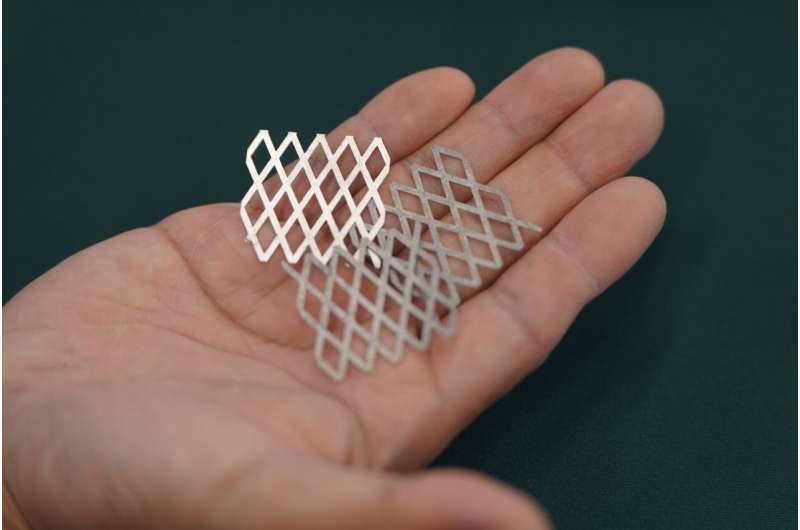This article has been reviewed according to Science X's editorial process and policies. Editors have highlighted the following attributes while ensuring the content's credibility:
fact-checked
peer-reviewed publication
trusted source
proofread
Engineering team develops new ultra stainless steel for hydrogen production

A research project led by Professor Mingxin Huang at the Department of Mechanical Engineering of the University of Hong Kong (HKU) has made a breakthrough in conventional stainless steel and the development of stainless steel for hydrogen (SS-H2).
This marks another major achievement by Professor Huang's team in its 'Super Steel' Project, following the development of the anti-COVID-19 stainless steel in 2021, and ultra-strong and ultra-tough Super Steel in 2017 and 2020 respectively.
The new steel developed by the team exhibits high corrosion resistance, enabling its potential application for green hydrogen production from seawater, where a novel sustainable solution is still in the pipeline.
The performance of the new steel in salt water electrolyzer is comparable to the current industrial practice using Titanium as structural parts to produce hydrogen from desalted seawater or acid, while the cost of the new steel is much cheaper.
The discovery has been published in Materials Today in the paper titled "A sequential dual-passivation strategy for designing stainless steel used above water oxidation." The research achievements are currently applying for patents in multiple countries, and two of them have already been granted authorization.
Since its discovery a century ago, stainless steel has always been an important material widely used in corrosive environments. Chromium is an essential element in establishing the corrosion resistance of stainless steel. Passive film is generated through the oxidation of chromium (Cr) and protects stainless steel in natural environments. Unfortunately, this conventional single-passivation mechanism based on Cr has halted further advancement of stainless steel.
Owing to the further oxidation of stable Cr2O3 into soluble Cr(VI) species, transpassive corrosion inevitably occurs in conventional stainless steel at ~1000 mV (saturated calomel electrode, SCE), which is below the potential required for water oxidation at ~1600 mV.
254SMO super stainless steel, for instance, is a benchmark among Cr-based anti-corrosion alloys and has superior pitting resistance in seawater; however, transpassive corrosion limits its application at higher potentials.
By using a "sequential dual-passivation" strategy, Professor Huang's research team developed the novel SS-H2 with superior corrosion resistance. In addition to the single Cr2O3-based passive layer, a secondary Mn-based layer forms on the preceding Cr-based layer at ~720 mV. The sequential dual-passivation mechanism prevents the SS-H2 from corrosion in chloride media to an ultra-high potential of 1700 mV. The SS-H2 demonstrates a fundamental breakthrough over conventional stainless steel.
"Initially, we did not believe it because the prevailing view is that Mn impairs the corrosion resistance of stainless steel. Mn-based passivation is a counter-intuitive discovery, which cannot be explained by current knowledge in corrosion science. However, when numerous atomic-level results were presented, we were convinced. Beyond being surprised, we cannot wait to exploit the mechanism," said Dr. Kaiping Yu, the first author of the article, whose Ph.D. is supervised by Professor Huang.
From the initial discovery of the innovative stainless steel to achieving a breakthrough in scientific understanding, and ultimately preparing for the official publication and hopefully its industrial application, the team devoted nearly six years to the work.
"Different from the current corrosion community, which mainly focuses on the resistance at natural potentials, we specialize in developing high-potential-resistant alloys. Our strategy overcame the fundamental limitation of conventional stainless steel and established a paradigm for alloy development applicable at high potentials. This breakthrough is exciting and brings new applications." Professor Huang said.
At present, for water electrolyzers in desalted seawater or acid solutions, expensive Au- or Pt-coated Ti are required for structural components. For instance, the total cost of a 10-megawatt PEM electrolysis tank system in its current stage is approximately HK$17.8 million, with the structural components contributing up to 53% of the overall expense.
The breakthrough made by Professor Huang's team makes it possible to replace these expensive structural components with more economical steel. As estimated, the employment of SS-H2 is expected to cut the cost of structural material by about 40 times, demonstrating a great foreground of industrial applications.
"From experimental materials to real products, such as meshes and foams, for water electrolyzers, there are still challenging tasks at hand. Currently, we have made a big step toward industrialization. Tons of SS-H2-based wire has been produced in collaboration with a factory from the Mainland. We are moving forward in applying the more economical SS-H2 in hydrogen production from renewable sources," added Professor Huang.
More information: Kaiping Yu et al, A sequential dual-passivation strategy for designing stainless steel used above water oxidation, Materials Today (2023). DOI: 10.1016/j.mattod.2023.07.022















